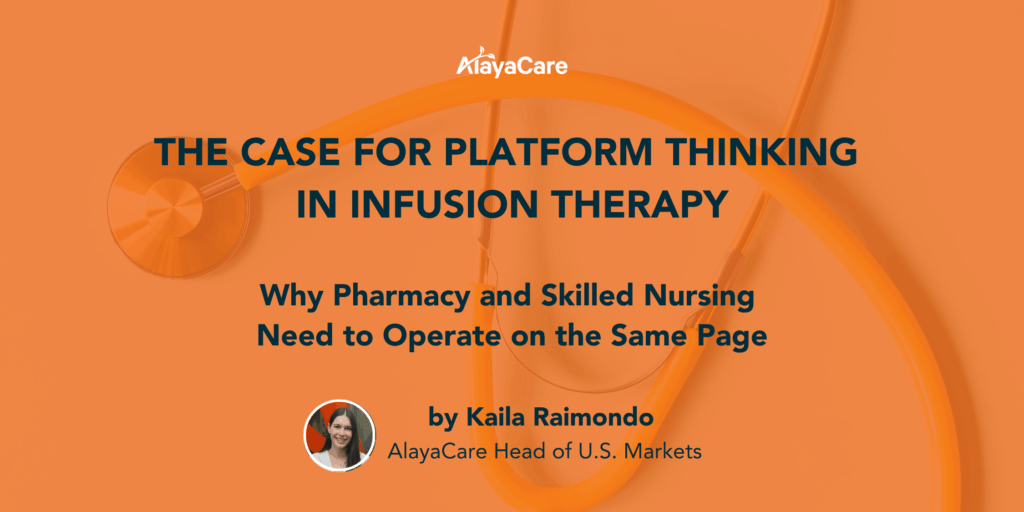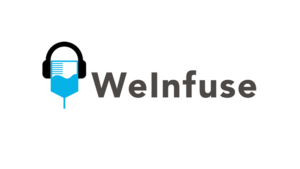Infusion therapy is a team effort, but too often, teams are working in silos. Nurses, pharmacists, schedulers, and billers all contribute to the care journey. When their systems aren’t connected, coordination breaks down. That leads to delays, duplication, and a frustrating experience for both patients and staff.
Platform thinking offers a better path. It means building your tech stack to reflect how care is actually delivered — not how departments are structured. When pharmacy and nursing workflows are aligned, teams can work more efficiently and deliver safer, more timely care.
Why coordination between pharmacy and nursing is hard
Pharmacy and skilled nursing roles rely on each other. Nurses can’t deliver therapy unless medications are available and verified. Pharmacists need clinical input from the field to track outcomes, side effects, and any needed adjustments. But in many organizations, each group uses separate tools and workflows. That’s where problems start.
Here are some common challenges:
- Nurses and pharmacists re-enter the same patient details in different systems.
- Appointments are scheduled without confirming if the medication is ready.
- Pharmacists miss critical updates from nursing visits.
- Documentation gaps slow down billing and follow-up care.
These disconnects don’t just cost time. They also increase the risk of errors and strain your workforce.
How disconnected systems impact care delivery
When pharmacy and skilled nursing don’t operate on the same page, the problems ripple out in every direction.
- Patient care is delayed. A nurse might show up without knowing the medication hasn’t shipped, or a change in the care plan hasn’t been communicated.
- Staff morale suffers. Teams are stuck doing repetitive manual work or fixing avoidable errors. Over time, this kind of inefficiency becomes a source of burnout.
- Billing and compliance issues grow. Missing or mismatched documentation can lead to denied claims, revenue loss, or even audit risk.
- Growth becomes harder. Adding new patients, locations, or services is more complicated when core workflows aren’t aligned.
All of this makes the case for a more connected approach to care coordination.
What platform thinking looks like in action
Platform thinking starts with a simple shift: instead of building tech around departments, build it around the patient journey.
A platform-based workflow might look like this:
- An order is received and pharmacy prep begins.
- Nursing availability is confirmed only once medication logistics are in place.
- Nurses document care using mobile tools that update the system in real time.
- Clinical documentation flows back to support pharmacy oversight and billing.
The process feels seamless because it’s connected. Each function still has the tools it needs, but those tools work together rather than in isolation.
Why this matters now
Infusion therapy is evolving. Demand for home-based care is rising. Patients expect faster, more coordinated service. At the same time, staffing shortages continue and administrative complexity keeps growing.
That makes platform thinking more than a technical concept. It’s a necessary strategy to deliver care at scale, reduce burnout, and keep operations running smoothly.
A real-world example: bridging pharmacy and nursing
The integration between WeInfuse and AlayaCare is a practical example of platform thinking in action. WeInfuse is designed for infusion center and pharmacy coordination. AlayaCare supports skilled nursing teams, especially in home-based care settings. Together, they connect two critical parts of the care process.
This integration allows:
- Nursing visits to be scheduled based on medication readiness.
- Real-time sharing of clinical updates and patient status.
- Faster billing supported by complete documentation.
Each platform retains its strengths but now works in sync. The result is smoother operations and fewer handoffs.
What better coordination unlocks
When pharmacy and nursing workflows are aligned, you get:
- Fewer redundant tasks for staff.
- Better visibility across teams.
- Shorter delays from referral to care delivery.
- Higher documentation accuracy.
- More timely claims and fewer missed charges.
These benefits improve both patient outcomes and staff satisfaction. And they free up time for clinical care instead of chasing paperwork.
Building with platform thinking in mind
You don’t need to replace every system you use. But it helps to audit how your tools interact. Ask questions like:
- Can your scheduler check for medication availability?
- Can pharmacists see notes from nursing visits?
- Does your billing team get documentation in real time?
- Are updates to care plans visible to everyone involved?
If the answer is no, you may be dealing with more friction than you realize.
Platform thinking isn’t about adding more tools. It’s about aligning what you already use so information flows freely and teams can stay in sync.
The long-term impact of connected care
Beyond solving day-to-day coordination issues, platform thinking also strengthens your organization’s foundation for growth. When workflows are built to support real-time data sharing and multi-role collaboration, you can:
- Onboard new staff faster with less training on disconnected systems.
- Launch new services or specialties without redesigning your processes.
- Respond to regulatory changes more efficiently.
- Monitor performance across departments from a single source of truth.
These are the kinds of structural advantages that help organizations adapt and thrive in a changing healthcare landscape.
Final thoughts
Pharmacy and skilled nursing are deeply linked. When they work together, care is faster, safer, and more efficient. When they’re disconnected, staff carry an extra burden, and patients feel the effects. Platform thinking helps teams coordinate better by removing barriers between systems. It’s not a silver bullet, but it’s a practical way to reduce manual work, lower risk, and deliver higher quality care. Infusion providers face enough challenges. Your software shouldn’t be one of them. With the right approach, technology can become a source of clarity — not complexity.
________________________________________________________________________
About The Author
Kaila Raimondo is the Head of U.S. Markets at AlayaCare, a leading cloud-based software provider for home and community care. She joined AlayaCare in 2018 and has played a pivotal role in scaling the company’s operations, beginning in customer success before moving into strategy and ultimately leading AlayaCare’s U.S. markets.
Kaila brings a deep understanding of the intersection between healthcare delivery and technology, helping providers improve clinical and financial outcomes through digital transformation. Her leadership has been key in aligning AlayaCare’s product and go-to-market teams to support enterprise providers across the U.S. homecare, home infusion & infusion and skilled nursing markets.
WeInfuse is dedicated to keeping infusion simplified by streamlining workflows for home infusion, specialty pharmacies, and infusion centers. WeInfuse software enables infusion operators to operate efficiently, decrease burnout, maximize profits, and improve clinical outcomes.
For more infusion insights, tune into the WeInfuse podcast, download our magazine, and subscribe to our blog.
See how WeInfuse is saving infusion operators both time and money with our ROI Calculators.




